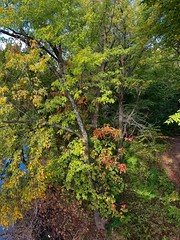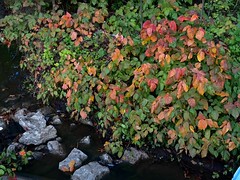I decided to spend the last part of my 2012 Spring Break at tourist sites I’d previously neglected in far northwestern Oklahoma, extending out to the very tip of the panhandle, or “No Man’s Land”. I spent many hours driving what signs proclaim as Oklahoma’s “Northwest Passage” during this three-day adventure.
I began with the exasperating drive west from Bartlesville to Ponca City along US 60. The route remains mostly a shoulderless two-lane road bobbing through the Osage Hills. I was delayed by the typical problems created by this inadequate road, stuck behind the slow wide load of a section of metal grain silo until the driver was able to pull over by the entrance to Osage Hills State Park and allow the accumulation of cars behind him to pass.
The weather was misty and overcast with frequent light rain all of the way to Ponca City, where the weather had the refinery producing immense clouds over the road as I turned north to visit Marland’s Grand Home.
E.W. Marland was a colorful oil man who became a self-made millionaire twice, married his adopted daughter, and became Oklahoma’s tenth governor. He made his first oil fortune back east and lost it in 1907, came west to the Ponca City area and by 1920 he was almost a billionaire in inflation-adjusted dollars. From 1914-1916 he had built for him and his first wife, Mary, a great home on Ponca’s Grand Avenue. He and Mary adopted her niece and nephew, Lydie and George, in 1916. After Mary died in 1926 E.W. had his adoption of Lydie annulled and married her in 1928. I’ve repeatedly visited the gorgeous Marland Mansion he built between 1925 and 1928, one mile from his Grand Avenue home. He only briefly enjoyed that grander estate with Lydie before his company was taken over by J.P. Morgan. Marland and Lydie vacated the mansion for its smaller artist studio and guest house by 1930.
Marland’s bad experiences with eastern banking interests made him an oddity among his fellow Oklahoma oil men: a New Deal Democrat who would be elected to congress for 1932-1934 and elected Oklahoma’s tenth governor from 1935-1939. He seemingly took his oath of honesty seriously, as he and Lydie were impoverished at the end of his term and moved into the former chauffeur’s quarters at the mansion in 1941, selling off the remaining mansion property, with E.W. Marland dying a few months later. Lydie lived in the chauffeur’s quarters until 1953, then roamed the country for 22 years working odd jobs. A childhood friend of hers financed her return to the chauffeur’s cottage in Ponca City in 1975, and Lydie lived there until her death in 1987.
I have thoroughly enjoyed each of my previous visits to the 1928 mansion and what remains of its grounds, but had never toured what is called “Marland’s Grand Home” – a fun play on words for the 22-room mansion he and Mary shared on Grand Avenue from 1916 to 1926. While the pink stucco home on Grand Avenue may pale in comparison to the magnificent mansion a mile to the northeast, the 16,500 square foot Italian Renaissance Revival home on Grand Avenue was a wonder for its day with its central vacuuming system, automatic dishwasher, attached three-car garage, and the first indoor swimming pool in Oklahoma.
The Grand Home once had extensive formal gardens stretching several blocks eastward as part of the 15 acre property, and despite later being sold for housing parcels you can see its traces to this day on the Ponca City street map, where 11th,12th, and 13th streets oddly do not connect Grand Avenue to Central Avenue one block south. The property had four hundred trees transplanted from the Arkansas River Valley as well as scores of magnolias from Avery Island, Louisiana.
While his later mansion was designed by architect John Duncan Forsyth, who would later design Bartlesville High School, the Grand Home was designed by Solomon Andrew Layton, whose firm designed many Oklahoma City landmarks including the State Capitol and Skirvin Hotel, and also designed such landmarks of the University of Oklahoma campus in Norman as the Evans administration building, Bizzell Memorial Library, and Oklahoma Memorial Stadium.
The entry foyer has a large hanging staircase with turned spindle balustrade, illuminated by a Waterford Crystal chandelier which is worth more than my annual take-home pay. To the right is the oak-paneled library, which features a large wall painting, commissioned by Mary and later retrieved from the mansion, of Marland and friends out on one of the silly fox hunts he set up out at Lake Ponca. A Marland Oil sign hangs nearby, its familiar form reminding us that his company became part of Conoco. Fireplaces and chandeliers are a focus of attention in the home, including the library.
To the left of the foyer is the living room, with a fireplace featuring marble from the palace of Maximilian and elegant accents. Farther east is my favorite room in any mansion, the sun room. This cheerful and more relaxed room has a floor of black and white marble squares and would have provided a view of the four city blocks of formal gardens. The adjoining dining room has dark walnut wainscoting with silver and mirror wall sconces, along with another Waterford Crystal chandelier. Artist George Stanley Lasarsky hand painted the walls above the wainscoting and later would do the same for Philbrook in Tulsa.
That was followed by the functional butler’s pantry and kitchen with the entire home reminding me greatly of the larger mansion nearby in style and comfort. Even the less showy areas of the home feature wonderful Art Deco light covers of varying styles.
The most unusual feature of the home is the indoor swimming pool under the east patio, reminding me of the former one at the White House, which is now the press briefing room. It originally was lit from above via glass squares in the patio deck. The remainder of the basement level has archeological displays and an extensive and fun collection of memorabilia from the Miller Brothers 101 Ranch and Wild West Show. Located seven miles south of Ponca City, the immense ranch was home to a touring show which thrived in the early twentieth century. The former three-car garage is home to some Daughters of the American Revolution memorabilia.
I took the grand staircase up to the second floor, which has a few Native American displays scattered about the former bedrooms. The stand out for me was a girl’s room with hand painted scenes of active teenage girls reminding me of the little vignettes decorating the interior covers of Grosset & Dunlap’s Nancy Drew books. I wonder if Lydie had any notion of what adventures awaited her?
I exited the home and admired the façade another pretty home on the northwest corner of 10th and Grand, and then drove a few blocks to the Spanish Colonial style City Hall built in 1917 and designed by Layton and Smith. I saved a tour of its interior for a future trip, but admired the statue of E.W. Marland, which was sculpted by Jo Davidson and moved from his estate when it was donated by Lydie to the city in 1941. There is a nice Cherokee Strip Land Run bronze out front, sculpted by Jo Saylors and funded by citizens to celebrate the centennial of the run. Ponca City is smaller than Bartlesville and has a similar oil industry history. It is interesting how Bartlesville retains a much larger corporate presence and a healthier economy, yet Ponca City has a grander public space.
It was time for a delicious lunch of fajitas with puffy chips at Enrique’s at the Ponca City airport. Then I drove 70 road miles southwest to Enid for my next stop: the bizarrely magnificent Midgley Museum.
I pulled up in front of a small rock house, and do I mean ROCK. Dan and Libby Midgley used their oil money to go a-hunting for animal trophies along with rocks, fossils, and petrified wood. They encrusted the entire house with 34 different kinds of stone, including immense petrified logs. The stones were collected in Oklahoma, Texas, New Mexico, and Arkansas, with most of the rocks and fossils found near Lake Texoma. I’m not sure all of the collection was acquired legally, since the kindly volunteer couple manning the museum for the local Masonic lodge mentioned that one load of petrified wood hauled in by Dan’s workers from Arizona turned out to be from the protected petrified forest and he was fined $40,000 for the transgression and then had to have it all hauled back home to Arizona.
Out front is an odd little Masonic display and a truly immense petrified stump. The Midgley home’s interior is a collection of both valuable and worthless bric-a-brac with more rock encrustations on both fireplaces. A big trophy room has mountings of many animals both Dan and Libby shot, although I preferred other oddities such as a large Pond Creek School stage fire curtain adorned with painted advertisements. Amongst the many impressive rock specimens lurked a space monkey image, which gives you a pretty good idea of the wackiness on display. It was a fun stop with friendly docents.
Then I headed out west on US 412 to intersect Highway 3, proclaimed repeatedly by highway signs as Governor George Nigh’s Northwest Passage. He spearheaded funding to improve that road leading northwest from Oklahoma City up into and along the Panhandle. I drove over 200 miles from Enid to Guymon, my resting place for the night before hiking Black Mesa the following day.
The heavy clouds were a pretty addition to a rather monotonous drive through farm fields and ranching pastures as low mesas began to dot the landscape. The sun was setting as I approached Guymon for a late pizza and a welcome hotel bed.








Pingback: NW Passage Day 2: Black Mesa « MEADOR.ORG